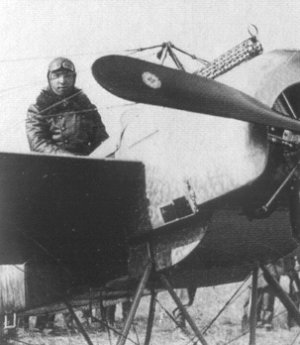- Fokker E.I
Infobox Aircraft
name = Fokker E.I
type = Fighter
manufacturer =Fokker 
caption =Max Immelmann of "Feldflieger Abteilung 62" in the cockpit of his Fokker E.I.
designer =Anthony Fokker
first flight = Early 1915
introduced = June 1915
retired =
status =
primary user = Imperial German Army Air Service
more users =
produced = 1915-1916
number built = 54
unit cost =
variants with their own articles = The Fokker E.I was the first successfulfighter aircraft to enter service with theGerman Army Air Service - in mid-1915. Its arrival at the front marked the start of a period known as the "Fokker Scourge " during which the E.I and itsFokker Eindecker successors achieved a measure ofair superiority over the Western Front.Design and development
The E.I was essentially an armed version of the
Fokker M.5K single-seatreconnaissance aircraftcitebook|last=Winchester|first=Jim|title=Fighter - The World's Finest Combat Aircraft - 1913 to the Present Day|year2006|publisher=barnes & Noble Publishing, Inc. and Parragon Publishing|isbn=0-7607-7957-0|pages=15] (military designation A.III), which was in turn very closely based on the design of the 1913 FrenchMorane-Saulnier Type H. Like the Morane, the Fokker was an externally braced mid-winged monoplane with a tapered box section fuselage, with fully movable horizontal and vertical stabilizing surfaces, also known as "flying" surfaces, giving the pilot the usual tail control functions - roll control was achieved through controlled wing warping, as was conventional in contemporary monoplanes. citebook|last=Winchester|first=Jim|title=Fighter - The World's Finest Combat Aircraft - 1913 to the Present Day|year2006|publisher=barnes & Noble Publishing, Inc. and Parragon Publishing|isbn=0-7607-7957-0|pages=15-16] Wing warping was achieved through external cables attached to the surface and running through a king post located in the front of the cockpit. The fuselage structure was fabric covered welded steel tubing - this constituted the biggest difference between the Fokker and the Morane, which had an entirely wooden framework. Welded steel tube provided the basis for the structure of all Fokker aircraft for many years.This unremarkable and derivative design was, however, transformed into a formidable fighter when it was fitted with the newly-developed synchronizer gear firing a single Parabellum LMG 14 or Spandau LMG 08
machine gun through the spinning propeller. Indeed the first five E.Is had been ordered and were under construction as A.IIIs but were completed as M.5K/MG aircraft, retaining the earlier "shoulder-wing" placement of the A.III type. Subsequent production E.Is had their wings lowered slightly from the M.5's shoulder configuration, which improved pilot visibility. (These were designated by Fokker as the M.14 which was also used for the following two Eindecker variants.)Operational history
Two German pilots, Leutnants
Otto Parschau andKurt Wintgens , worked very closely with Anthony Fokker in early 1915 during the introduction of the M.5K/MG aircraft to evaluational service. Parschau was given the first production M.5K/MG, serial number E.1/15. Wintgens received the last aircraft, serial number E.5/15. Wintgens was flying this aircraft when he scored the first true fighter victory in aviation history on July 1, 1915, over a two-seatMorane-Saulnier Type L parasol monoplane.The E.I was mainly flown by the ordinary "Fliegertruppe" of the
German Army - the formation of specialised fighter squadrons in the German air service was still to come. Two were supplied to the Austro-Hungarian air force and five to the "Kaiserliche Marine " in April 1916. The E.I was soon joined by the improvedFokker E.II and, as the first E.Is were entering service in June 1915, the first of the E.II type was being demonstrated byAnthony Fokker . However, E.I production continued in parallel with the E.II and output of the types depended on the availability of the Oberursel engines; the 80-hp U.0 copy of the Gnôme Lambda rotary engine for the E.I and the 100-hp U.I copy of the Gnôme Monosoupape for the E.II. In fact, E.Is were still being produced in 1916 well after E.II production had ceased, having been superseded by theFokker E.III . By 1916, a total of 54 had been manufactured and delivered to theGerman Army , Navy and the Austro-Hungarian army.citebook|last=Winchester|first=Jim|title=Fighter - The World's Finest Combat Aircraft - 1913 to the Present Day|year2006|publisher=barnes & Noble Publishing, Inc. and Parragon Publishing|isbn=0-7607-7957-0|page=16]Operators
;flag|Austria-Hungary
*"Kaiserliche und Königliche Luftfahrtruppen";flag|German Empire
*"Luftstreitkräfte "
*"Kaiserliche Marine "pecifications (E.I.)
aircraft specifications
plane or copter?=plane
jet or prop?=prop
ref=
crew=one, pilot
capacity=
payload main=
payload alt=
length main= 7.22 m
length alt= 23 ft 7 in
span main= 8.85 m
span alt= 29 ft 0 in
height main= 2.9 m
height alt= 9 ft 5½ in
area main= 15.9 m²
area alt= 172.2 ft²
airfoil=
empty weight main= 360 kg
empty weight alt= 789 lb
loaded weight main= 563 kg
loaded weight alt= 1,241 lb
useful load main=
useful load alt=
max takeoff weight main=
max takeoff weight alt=
more general=
engine (prop)= Oberursel U.0 7-cylinder air-cooledrotary engine (clone of Gnôme Lambda engine)
type of prop=
number of props=1
power main= 80 hp
power alt= 59.6 kW
power original=
max speed main=130 km/h
max speed alt= 81 mph
cruise speed main=
cruise speed alt=
stall speed main=
stall speed alt=
never exceed speed main=
never exceed speed alt=
range main= 198 km at 110 km/h
range alt= 123 miles at 68 mph
ceiling main= 3,000 m
ceiling alt= 9,840 ft
climb rate main= 20 min to 2,000 m
climb rate alt= 6,560 ft
loading main=
loading alt=
thrust/weight=
power/mass main=
power/mass alt=
more performance=
armament=
* 1 × forward-firing Spandau LMG 08machine gun
avionics=ee also
aircontent
related=
*Fokker M.5K
*Fokker E.II similar aircraft=
lists=
*List of military aircraft of Germany see also=
References
Wikimedia Foundation. 2010.
